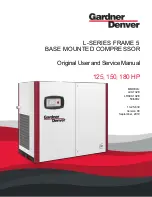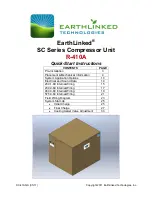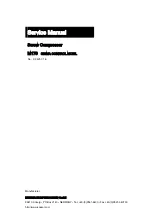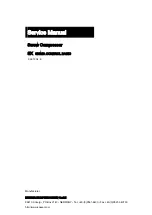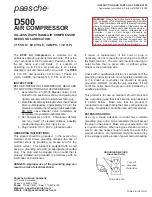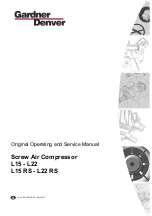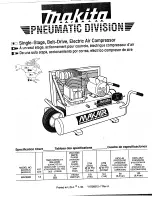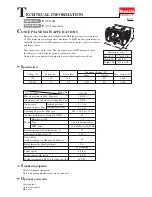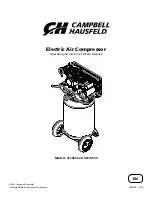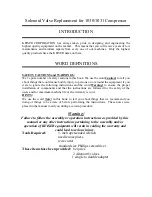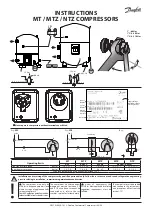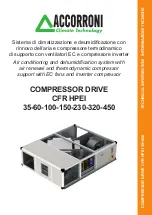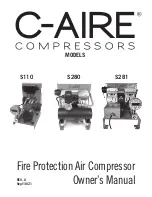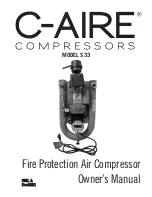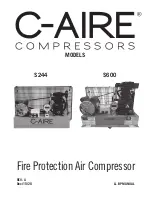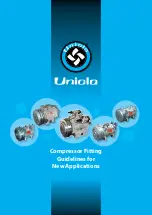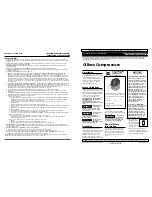
Contens
1 - Introduction
2 - Transportation, storage
3 - Safety measures prior to assembly
4 - Assembly
5 - Leak detection
6 - Vacuum dehydration procedure
7 - Electrical connections
8 - Filling the system
9 - Verification before commissioning
10 - Start up
11 - Troubleshooting
12 - Maintenance
13 - Replacement
14 - User advisory
1 - Introduction
These instructions pertain to the Maneurop
®
hermetic reciprocating compressors used for A/C
and refrigeration purposes. They are intended to
provide necessary information regarding safety
features and proper handling of this product.
Note that this is a general document for the entire
range of reciprocating compressors; certain details
therefore may not be applicable to the particular
model you purchased. Please keep your manual and
all relevant information handy for future reference.
• Equipment description: This compressor is
delivered with all assembly equipment (rubber
gr washers), an electrical box
(cover + spring), connecting sleeves and gaskets,
and instructions.
• Approved list of refrigerants:
-
The MT series can be used with R22, R12 and
R502.
-
The MTZ series can be used with R404A,
R507A, R134a and R407C.
-
The LT series can be used with R502 and R22
(booster).
-
The LTZ series can be used with R404A and
R507A.
• Compressors are filled with lubricant before
leaving the factory:
-
The MT and LT series with mineral oil (ref. 160P),
-
The MTZ series with polyolester oil (ref. 160PZ),
-
The LTZ series with polyolester oil (ref. 160Z).
These lubricants must not be mixed with one
another.
Be aware that alkylbenzen oil (ref. 160ABM) is
available for refrigerant substitutes (not listed on
the compressor nameplate), yet is never filled in
the compressors at the factory.
• Maneurop
®
compressors must only be used for
their designed purpose(s) and within their scope
of application (refer to Fig. 1).
Compressors are delivered under nitrogen
gas pressure (between 1 and 2 bar) and hence
cannot be connected as is; please refer to the
«
Assembly
» section for further details.
Compressors are not certified for mobile and
explosion-proof applications. Any use of flammable
refrigerant (e.g. hydrocarbons) or air is also strictly
forbidden.
• Under all circumstances, the EN378 (or other
applicable local regulation) requirement must be
fulfilled.
When pressure tests are required on the
system, they are to be performed by qualified
personnel, in paying close attention to potential
pressure related hazards and heeding the pressure
limits displayed on the compressor nameplate or
in the application guidelines.
Modifications or alterations (such as brazing
on the shell) not expressly approved by the party
responsible for ensuring compliance could
invalidate the user’s authorization to operate the
equipment.
2 - Transportation, storage
• The compressor must be handled in the vertical
position (maximum offset from the vertical: 15°).
Should the compressor be handled in an upside-
down position, its performance may no longer be
insured.
• Beware that all compressor handling must be
carried out with extreme caution to avoid any
shocks. Dedicated packing handles are to be used
for all required manipulation of the compressor;
otherwise appropriate and safe lifting equipment
is to be used during handling and unpacking.
• Any damage noticed on either the packaging
or the product itself upon reception should
be indicated on a Customer Claim addressed to
the shipping company.The same recommendation
applies to all instances when transport instructions
have not been fully respected.
• Please review the safety instructions printed on
the cardboard packaging before storage.
• Verify that the compressor is never stored in an
ambient temperature of below -35°C (-31°F) or
above 50°C (122°F).
• Ensure that the compressor and its packaging
are not exposed to rain and/or a corrosive,
flammable atmosphere.
3 - Safety measures prior to assembly
• All installation and servicing is to be performed by
qualified personnel in compliance with all pertinent
practices and safety procedures.
• The compressor must be located in a ventilated
area to ensure that the ambient temperature
never exceeds 50°C (122°F) during the off-cycle.
• Make certain that the compressor can be mounted
onto a horizontal plane with a maximum slope
of 3°.
• Check that the compressor model corresponds
to system specifications (capacity, use of refrigerant,
etc.).
• Verify that the power supply corresponds to
compressor motor characteristics (refer to the
compressor nameplate for precision).
• Ensure that refrigerant charging equipment,
vacuum pumps, etc. for HFC refrigerant systems
have been specifically reserved for these
refrigerants and never used with other CFC,
HCFC refrigerants.
• Use only clean and dehydrated refrigeration-grade
copper tubes as well as silver alloy brazing material.
• Verify that all system components are appropriate
(use of refrigerant, etc.), clean and dehydrated
before being connected to the completed assembly.
• Perform a check on the suction lines: horizontal
sections are to be sloped downwards towards the
compressor. Suction gas velocity must be high
enough to provide for an adequate oil return. This
velocity must be with in 8 to 12 m/s in vertical
risers. In horizontal pipes, this velocity can
decrease to 4 m/s.
• The use of U-trap and double-suction risers may
be required on vertical sections, but not in excess
of 4 m unless a second U-trap system has been
fitted (refer to Figs. 3 and 4). Suction line piping
must be insulated in order to minimize the effects
of superheating.
• Perform a check on the discharge lines : piping
to the condenser must be designed so as to
prevent liquid return to the compressor. The
use of non-return valves may prove necessary,
depending on the position of the compressor with
respect to the condenser. A suitably-sized U-trap
may also be necessary if the condenser has been
placed above the compressor (refer to Fig. 2).
• The piping connected to the compressor must
be configured on the basis of a flexible 3-axis
design to dampen vibrations and designed in
such a way as to prevent free liquid refrigerant
migration and drainage back to the compressor
sump and discharge cylinder heads (refer to fig. 2).
Note that all local and regional regulations and
safety standards, such as EN378, must be taken
into account when designing, connecting and
running the system.
4 - Assembly
The compressor’s time of exposure to the
atmosphere during installation shall be held to
aminimum (less than 1/2 hour). The compressor
connection must be fast in order to avoid moisture
contamination of the lubricant.
• The grommets must be installed under the
compressor feet, as shown in Fig. 5. Rubber
grommets are to undergo compression until
contact is made between the flat washer and the
steel mounting sleeve.
Before opening the compressor connection
fittings, it is mandatory to connect a 1” service hose
to the Schrader fitting on the compressor shell in
order to gradually release the nitrogen holding
charge.
• Ensure that no material enters into the system
while cutting the tubing. Moreover, never drill
holes in the pipe work after installation.
• Should additional components need to be
connected onto the compressor sight glass or oil
equalization ports, it is recommended that such
an operation be carried out prior to final assembly,
to allow for compressor inclination and movement.
• Avoid flare-type connections and exercise great
care while brazing (use only state-of-the-art
practices); apply a nitrogen gas flow to prevent
oxidation inside the tubing, especially when HFC
refrigerants are being used. All brazing material is
to contain a minimum of 5% silver. If flux additive
is used, don't put the copper tube into the receiver of
flux, but put flux around the tube (i.e. with a pencil).
This will prevent pure flux getting inside the tube.
• When brazing, protect the terminal box and
painted surfaces of the compressor from torch
heat damage.
• Remove the Teflon gaskets when brazing
Rotolock connectors with the solder sleeve and
be aware that original suction and discharge
gaskets must be replaced.
• When installing Rotolock fittings, always use two
wrenches when tightening any fittings to insure that
the torque is effectively cancelled on the adjacent
tubing and fittings. Do not exceed the maximum
tightening torque for Rotolock connections to the
compressor :
1 ” rotolock 80 Nm
1 ” 1/4 rotolock 90 Nm
1 ” 3/4 rotolock 110 Nm.
• Be sure to connect the required safety and
control devices onto compressor shut-off valves
or fittings. In case of oil return through the
Schrader fitting on the compressor shell, make
sure the internal valve is removed.
Instructions
3
8510196 P02-A © Danfoss Commercial Compressors 06/04
Summary of Contents for Maneurop LTZ-R404A
Page 2: ...2 8510196 P02 A Danfoss Commercial Compressors 06 04 RECIPROCATING COMPRESSORS ...
Page 6: ...6 ...
Page 7: ...7 8510196 P02 A Danfoss Commercial Compressors 06 04 RECIPROCATING COMPRESSORS ...
Page 12: ...12 ...
Page 13: ...13 8510196 P02 A Danfoss Commercial Compressors 06 04 RECIPROCATING COMPRESSORS ...
Page 18: ...18 ...
Page 19: ...19 8510196 P02 A Danfoss Commercial Compressors 06 04 RECIPROCATING COMPRESSORS ...



















